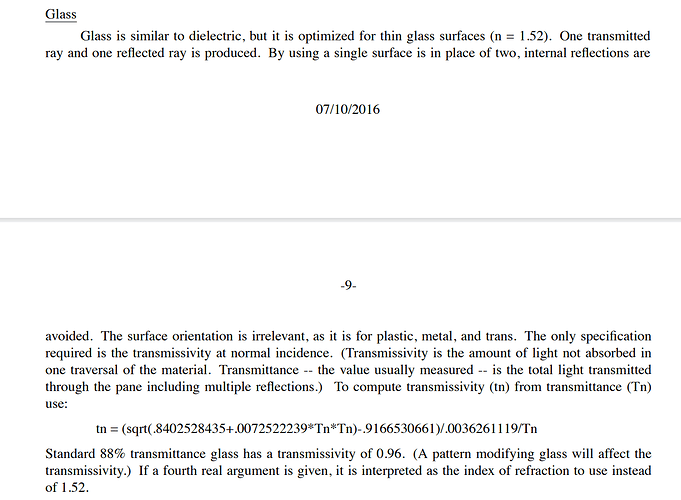Hello everyone,
I have a very simple question. For glass material, there is a formula for the transmittance and transmissivity conversion. If the transmittance provided is 0.95, the transmissivity will be 1.03 after calculation, which is greater than 1. But, transmissivity should be lower than 1.
Thanks,
Green
Which formula are you referring to? Is it the approximate one in “ray/src/cal/cal/trans2.cal” ?
In any case, it is not possible to have a normal transmittance of 0.95 with the index of refraction of typical glass, which reflects about 7% of the incident light. 0.95 + 0.07 = 1.02. This is probably why you get a non-physical transmissivity value from your formula.
Best,
-Greg
Hi Greg,
The formula is the one from the tutorial. The reason I am asking this question is that I found there are some glazing materials with high value of Tvis in Window software such as 0.95. I assume that the Tvis here means transmittance, so I want to convert it for glass material definition in radiance.
Maybe I can calculate the transmissivity by adding the provided transmittance(Tvis) and reflectance(Rvis) together, which will be near 1.0.
You are better off using icalc with the approximate formula I mentioned in ray/src/cal/cal/trans2.cal to get transmission (tn) from normal transmittance (Tn) and normal reflectance (Rn). The computed index of refraction (n) should be close to 1.5 for standard glass.
The following should work, with an example for 88% transmittance glass. The lines with prompts are what you enter, and the lines that look like $1=… are what you get from icalc:
> icalc trans2.cal
> Tn = 0.88
> Rn = 0.08
> tn
$1=0.956521739
> n
$2=1.51380703
-Greg
Thanks a lot, Greg. This is helpful!
